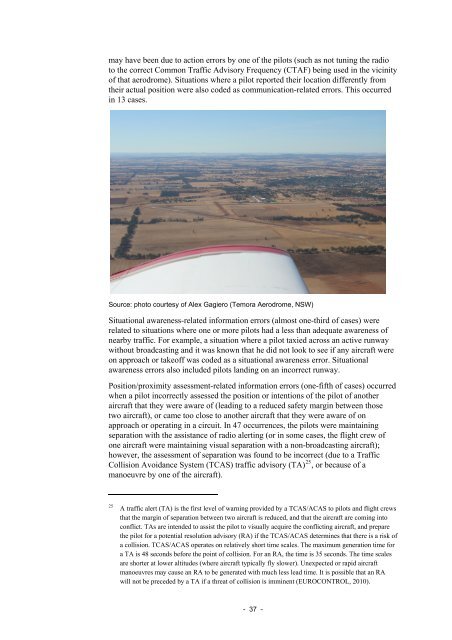Safety in the vicinity of non-towered aerodromes - Australian ...
Safety in the vicinity of non-towered aerodromes - Australian ...
Safety in the vicinity of non-towered aerodromes - Australian ...
You also want an ePaper? Increase the reach of your titles
YUMPU automatically turns print PDFs into web optimized ePapers that Google loves.
may have been due to action errors by one <strong>of</strong> <strong>the</strong> pilots (such as not tun<strong>in</strong>g <strong>the</strong> radio<br />
to <strong>the</strong> correct Common Traffic Advisory Frequency (CTAF) be<strong>in</strong>g used <strong>in</strong> <strong>the</strong> vic<strong>in</strong>ity<br />
<strong>of</strong> that aerodrome). Situations where a pilot reported <strong>the</strong>ir location differently from<br />
<strong>the</strong>ir actual position were also coded as communication-related errors. This occurred<br />
<strong>in</strong> 13 cases.<br />
Source: photo courtesy <strong>of</strong> Alex Gagiero (Temora Aerodrome, NSW)<br />
Situational awareness-related <strong>in</strong>formation errors (almost one-third <strong>of</strong> cases) were<br />
related to situations where one or more pilots had a less than adequate awareness <strong>of</strong><br />
nearby traffic. For example, a situation where a pilot taxied across an active runway<br />
without broadcast<strong>in</strong>g and it was known that he did not look to see if any aircraft were<br />
on approach or take<strong>of</strong>f was coded as a situational awareness error. Situational<br />
awareness errors also <strong>in</strong>cluded pilots land<strong>in</strong>g on an <strong>in</strong>correct runway.<br />
Position/proximity assessment-related <strong>in</strong>formation errors (one-fifth <strong>of</strong> cases) occurred<br />
when a pilot <strong>in</strong>correctly assessed <strong>the</strong> position or <strong>in</strong>tentions <strong>of</strong> <strong>the</strong> pilot <strong>of</strong> ano<strong>the</strong>r<br />
aircraft that <strong>the</strong>y were aware <strong>of</strong> (lead<strong>in</strong>g to a reduced safety marg<strong>in</strong> between those<br />
two aircraft), or came too close to ano<strong>the</strong>r aircraft that <strong>the</strong>y were aware <strong>of</strong> on<br />
approach or operat<strong>in</strong>g <strong>in</strong> a circuit. In 47 occurrences, <strong>the</strong> pilots were ma<strong>in</strong>ta<strong>in</strong><strong>in</strong>g<br />
separation with <strong>the</strong> assistance <strong>of</strong> radio alert<strong>in</strong>g (or <strong>in</strong> some cases, <strong>the</strong> flight crew <strong>of</strong><br />
one aircraft were ma<strong>in</strong>ta<strong>in</strong><strong>in</strong>g visual separation with a <strong>non</strong>-broadcast<strong>in</strong>g aircraft);<br />
however, <strong>the</strong> assessment <strong>of</strong> separation was found to be <strong>in</strong>correct (due to a Traffic<br />
Collision Avoidance System (TCAS) traffic advisory (TA) 25 , or because <strong>of</strong> a<br />
manoeuvre by one <strong>of</strong> <strong>the</strong> aircraft).<br />
25 A traffic alert (TA) is <strong>the</strong> first level <strong>of</strong> warn<strong>in</strong>g provided by a TCAS/ACAS to pilots and flight crews<br />
that <strong>the</strong> marg<strong>in</strong> <strong>of</strong> separation between two aircraft is reduced, and that <strong>the</strong> aircraft are com<strong>in</strong>g <strong>in</strong>to<br />
conflict. TAs are <strong>in</strong>tended to assist <strong>the</strong> pilot to visually acquire <strong>the</strong> conflict<strong>in</strong>g aircraft, and prepare<br />
<strong>the</strong> pilot for a potential resolution advisory (RA) if <strong>the</strong> TCAS/ACAS determ<strong>in</strong>es that <strong>the</strong>re is a risk <strong>of</strong><br />
a collision. TCAS/ACAS operates on relatively short time scales. The maximum generation time for<br />
a TA is 48 seconds before <strong>the</strong> po<strong>in</strong>t <strong>of</strong> collision. For an RA, <strong>the</strong> time is 35 seconds. The time scales<br />
are shorter at lower altitudes (where aircraft typically fly slower). Unexpected or rapid aircraft<br />
manoeuvres may cause an RA to be generated with much less lead time. It is possible that an RA<br />
will not be preceded by a TA if a threat <strong>of</strong> collision is imm<strong>in</strong>ent (EUROCONTROL, 2010).<br />
- 37 -
















